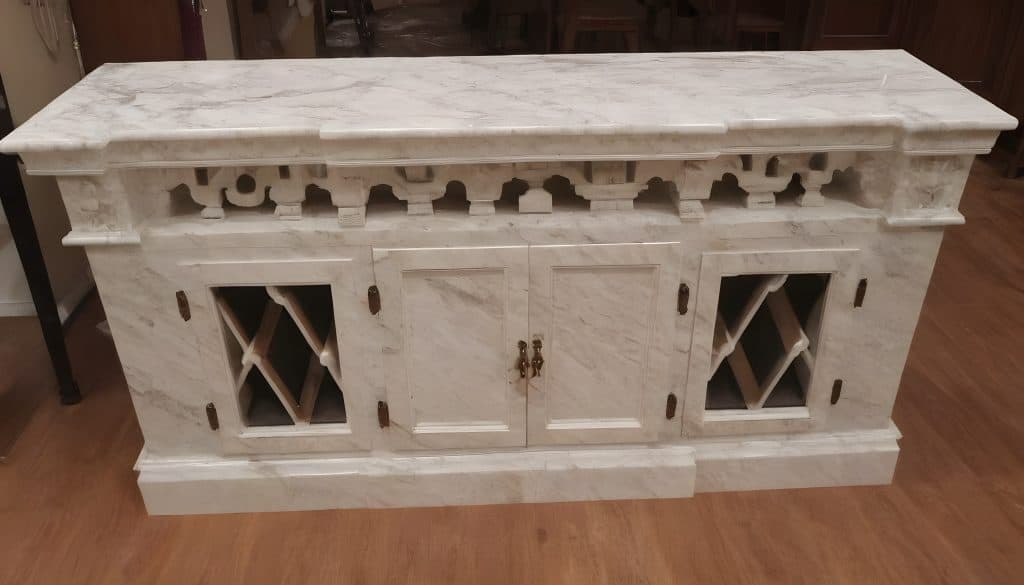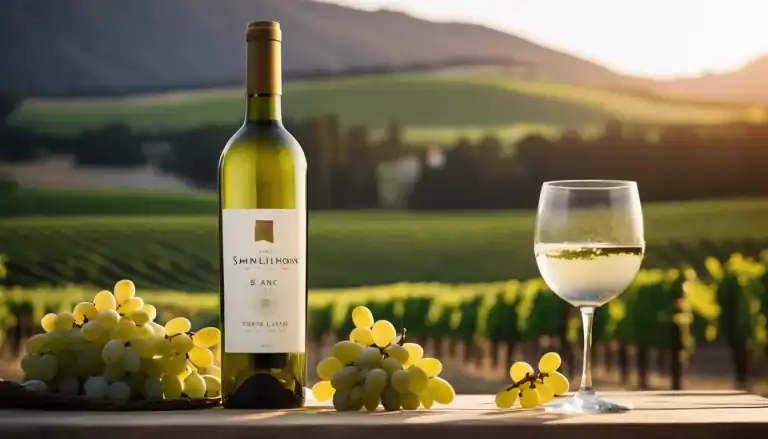The choice of materials for wine cabinets significantly impacts the functionality, aesthetics, and longevity of your wine collection. Which is the best wine cabinet material?
In this article, we explore the advantages and drawbacks of various commonly used materials. Let’s find out which one is the best wine cabinet material for you.
Welcome to Didi Somm and Cheers!
Important Notice: The information in this article is for general and public information purposes only. It solely reflects Didi Somm’s or his Staff’s opinion, and no responsibility can be assumed for errors or omissions in the service’s contents. For details, please check the Disclaimer at the bottom of the homepage.

Key Takeaways
- Material choice impacts storage conditions – wood insulates, metal endures
- Wooden cabinets excel in temp control but need maintenance
- Metal/glass offers modern style with minimal upkeep but temp varies
- Stone provides durability and insulation but costs more
- UV-resistant glass essential for protecting wine quality
- Material combinations often deliver best overall performance
1. The Wooden Wine Cabinet
A wine cabinet made of wood offers several superior characteristics that make it a popular choice among wine enthusiasts. It is generally considered one of the best wine cabinet material.

Wood Selection:
Choosing a stable, durable species free from toxins or chemicals that could affect the stored wines is essential. Some popular choices include:
- Mahogany is prized for its rich color, fine grain, and natural resistance to moisture and pests.
- Redwood is renowned for its beautiful reddish-brown hue and resistance to decay and rot.
- Oak is a classic choice and one of the best wine cabinet materials. It is known for its strength, durability, and distinctive grain patterns.
- Cherry wood features warm tones and a smooth, even grain that ages beautifully over time.
- Walnut wood boasts rich, dark hues and intricate grain patterns that add depth and character to wine cabinets.
2. The Metal Wine Cabinet
Metal wine cabinets offer a modern, minimalist alternative to traditional wooden cabinets. We especially recommend the stylish and timeless combination of metal/glass and metal/wood.

Metal Selection:
Several types of metal are recommended for their durability, strength, and corrosion resistance. Some popular choices include:
- Stainless steel is a versatile and corrosion-resistant alloy that is commonly used in wine cabinet construction.
- Aluminum is lightweight yet durable, making it a practical choice for wine cabinets that may require mobility or portability.
- Wrought iron is known for its strength, resilience, and decorative appeal.
- Powder coating is a durable and decorative finish applied to metal surfaces to enhance their appearance and resistance to corrosion.
3. The Glass Wine Cabinet
Glass wine cabinets offer a visually stunning way to display your wine collection while protecting it from external elements.

Glass Type Selection:
When selecting glass for making wine cabinets, several types of glass are recommended for their clarity, durability, and safety features. Some popular choices include:
- Tempered glass is heat-treated to increase its strength and resistance to impact.
- Low-iron glass, also known as ultra-clear glass, is manufactured with reduced iron content to enhance clarity and transparency.
- Double-pane insulated glass consists of two layers of glass separated by a spacer filled with inert gas. It provides enhanced insulation properties.
- UV-resistant glass is treated with special coatings to block harmful ultraviolet rays that can degrade wine quality and cause label fading.
4. The Stone Wine Cabinet
A wine cabinet made of stone offers unique characteristics that make it an exceptional choice for wine storage, particularly in luxurious and high-end settings.


Stone Type Selection:
Several types of stone are recommended for their durability, aesthetic appeal, and suitability for wine storage. Some popular choices include:
- Marble is prized for its timeless beauty, unique veining patterns, and luxurious appearance.
- Granite is renowned for its durability, strength, and resistance to scratches and stains.
- Travertine is a sedimentary rock characterized by its porous texture and natural warmth.
- Limestone is a soft and porous stone that offers a timeless elegance and understated beauty.
5. The Plastic Wine Cabinet
Wine cabinets made from Plastic (e.g. Polypropylene/PP or Acrylic/PMMA) offer a lightweight and affordable alternative to traditional materials, catering to practical storage needs. Some popular choices are:

Plastic Type Selection:
- Polyethylene (PE) is typically one of the most affordable options among plastics used in wine cabinets.
- Polypropylene (PP) is slightly more expensive than polyethylene but still relatively affordable.
- Polycarbonate (PC) tends to be more expensive than polyethylene and polypropylene due to its superior impact resistance and transparency.
- Acrylic (PMMA) is generally one of the more expensive plastics due to its optical clarity and durability. It offers a glass-like appearance (see the picture above) while being lighter and more impact-resistant than glass.
FAQ – best wine cabinet material
- Which is the best Wine Cabinet Material?
The best material depends on insulation, aesthetics, and personal preferences. Wood, metal, glass, and stone all have their unique advantages.
- Do Different Materials Affect Wine Aging?
Yes, different materials can affect wine aging due to their varying insulation properties and ability to maintain stable temperature and humidity levels.
- How Does Wood vs. Metal Impact Temperature Control?
Wood offers natural insulation, while metal may conduct heat more readily. The choice depends on desired temperature stability (cooling system) and environmental factors, e.g. location in the room.
- Are Glass Cabinets Suitable for Long-Term Wine Storage?
Glass cabinets can be suitable for long-term storage if they have UV-resistant coatings, proper insulation, and a cooling system to protect wines from light exposure and temperature fluctuations.
- What Types of Wood Are Recommended for Wine Cabinets?
Mahogany, redwood, oak, cherry, and walnut are commonly recommended for wine cabinets due to their durability, aesthetics, and insulation properties.
- Is Plastic a Viable Material for Wine Storage?
Plastic can be a viable option for wine storage, offering affordability and versatility. However, it may not provide the same insulation and aesthetic appeal as other materials.
- How Does Stone Contribute to Wine Cabinet Durability?
Stone is highly durable and resistant to wear, providing excellent longevity for wine cabinets. Its natural insulation properties also help maintain stable storage conditions. Stone is a perfect fit with wooden elements, such as wooden wine racks.
- Are There Special Considerations for Metal Wine Cabinets?
Metal wine cabinets require consideration regarding heat conductivity and potential for condensation. Proper insulation and sealing techniques are essential for optimal performance.
- Do Different Materials Impact the Aroma and Taste of Wines?
Yes, materials like wood can impart subtle flavors to wines over time. However, the impact on aroma and taste is generally minimal if proper storage conditions are maintained.
- What Maintenance Is Required for Each Material?
Maintenance requirements vary by material. Wood may need refinishing and polishing, while metal and glass require regular cleaning. Stone may need sealing to protect against moisture and stains. We strongly recommend to consult with the seller/manufacturer to ensure proper servicing and maintenance.
Conclusion
The choice of material for wine cabinets depends on factors such as aesthetics, personal preferences, budget constraints, and storage requirements (e.g., the size of the wine collection).
To recap, wood offers timeless elegance and insulation properties, while metal provides durability and modern aesthetics. Glass showcases wines beautifully but requires careful maintenance. Stone exudes luxury but has a higher price tag and weight considerations. Plastic/Acrylic offers affordability and practicality but may lack the aesthetic appeal of other materials. For wine ranking, I recommend you check the Wine Racks America website for information and inspiration.
My personal choice for “best wine cabinet material” is a combination of wood or metal with other materials, striking a balance between functionality, aesthetics, and budget considerations.
I hope you got some new ideas and inspiration to find your personal best choice, too. Enjoy your wine cabinet and your precious collection, and Cheers!
For your reference – the latest articles by Didi Somm include:
- The Art of Wine Storage: 30 Best Tips to Preserve Your Wines
- Best Wine Refrigerators in 2024
- How to Choose a Wine Cabinet? – 7 Essential Questions Answered
Important Notice: The information in this article is for general and public information purposes only. It solely reflects Didi Somm’s or his Staff’s opinion, and no responsibility can be assumed for errors or omissions in the Service’s contents —for details, please check the Disclaimer at the bottom of the homepage.





